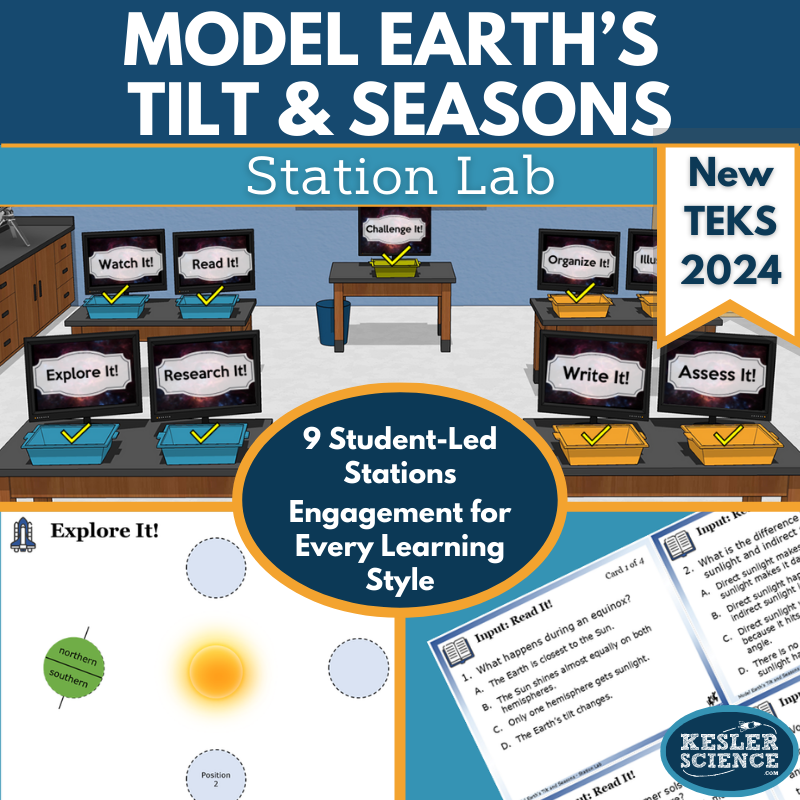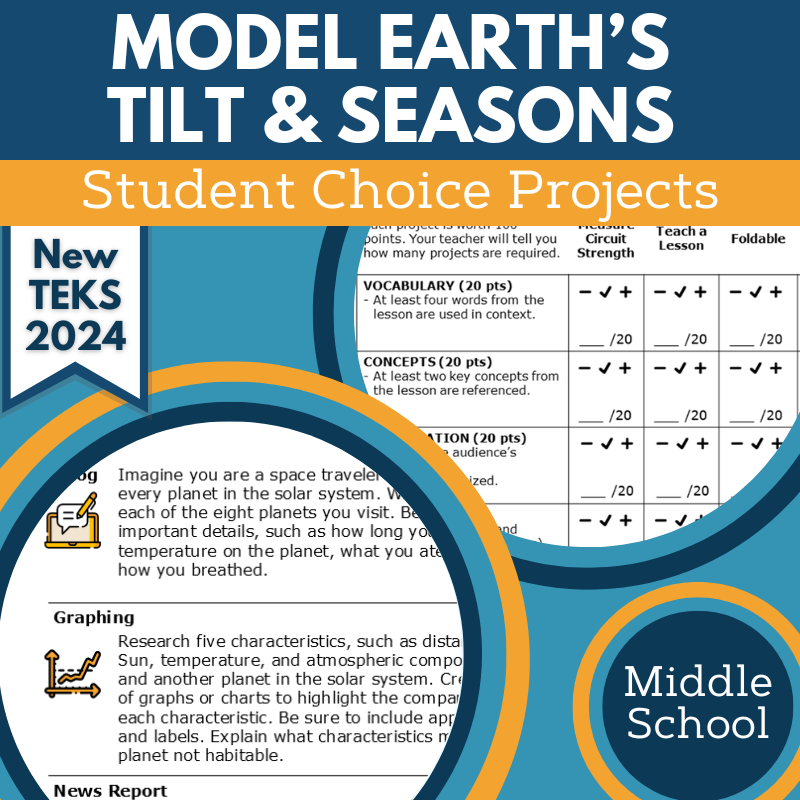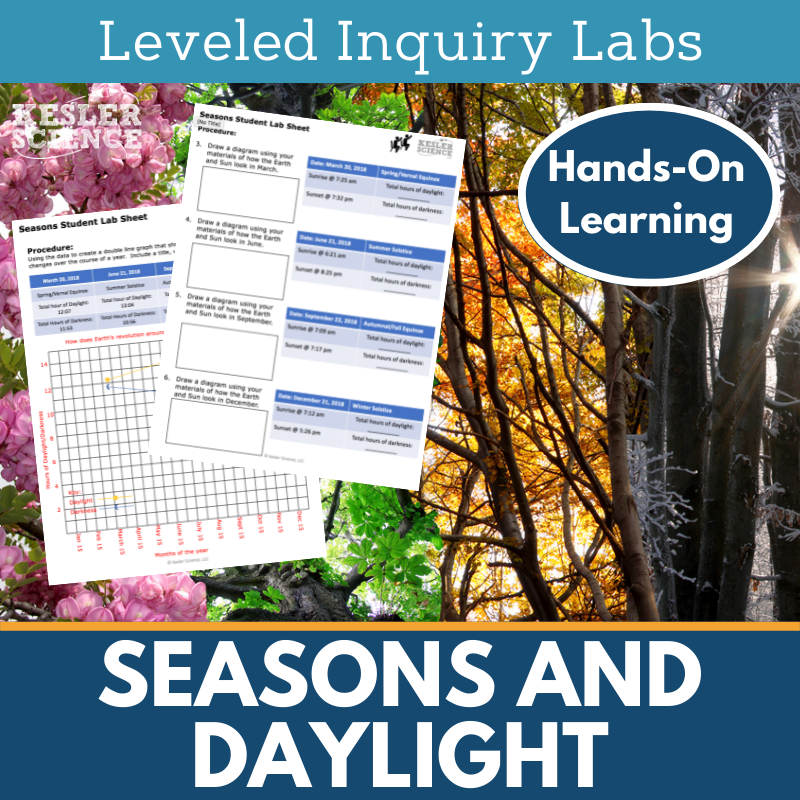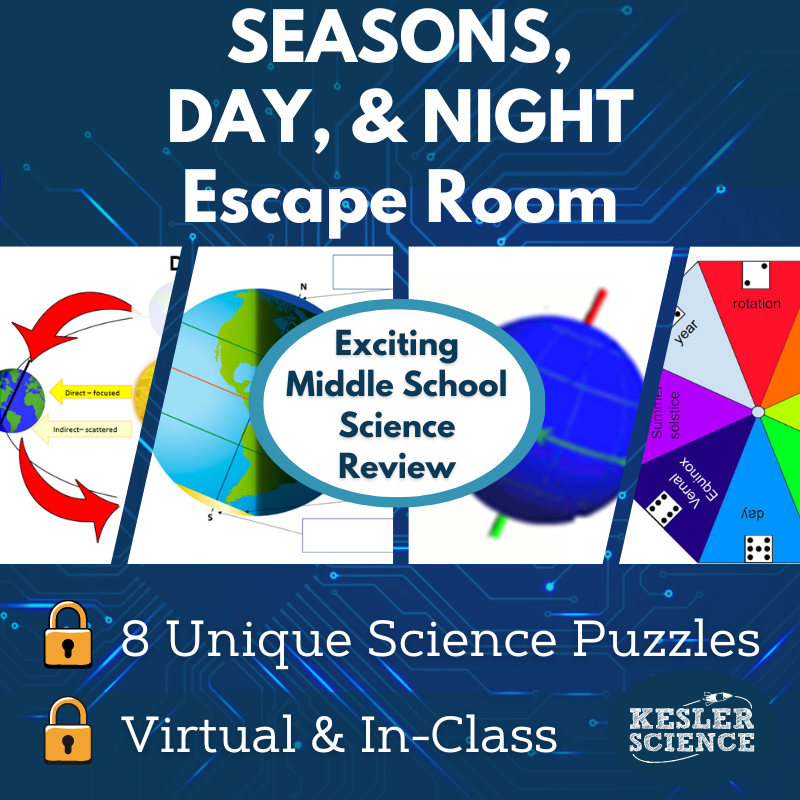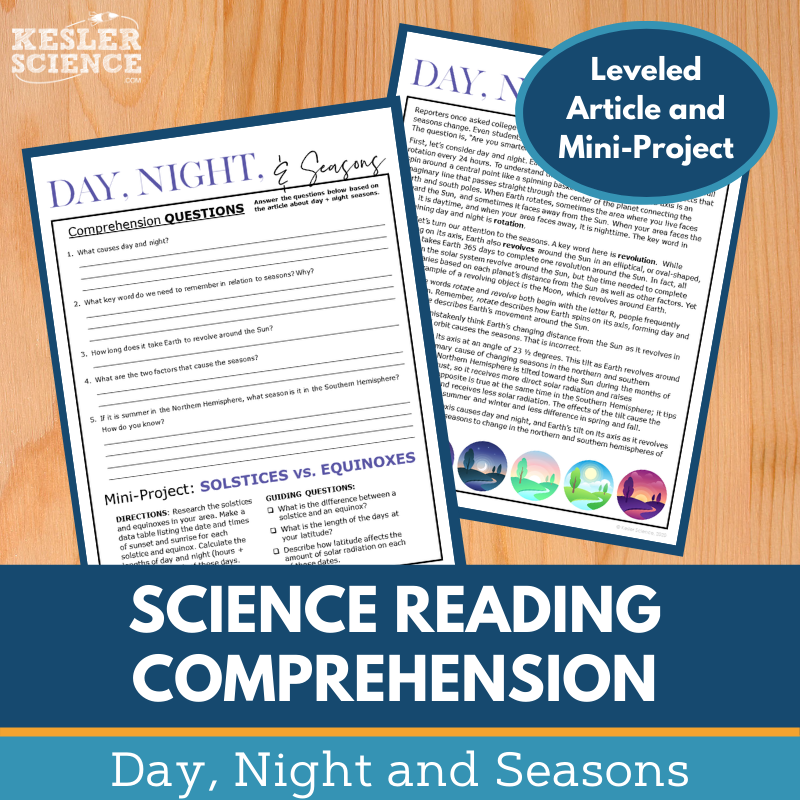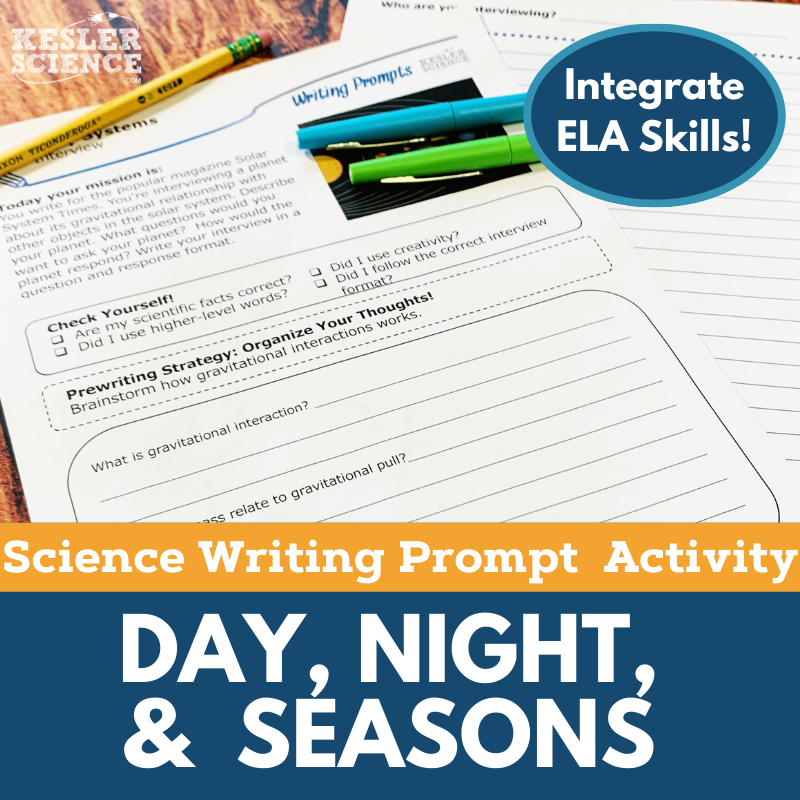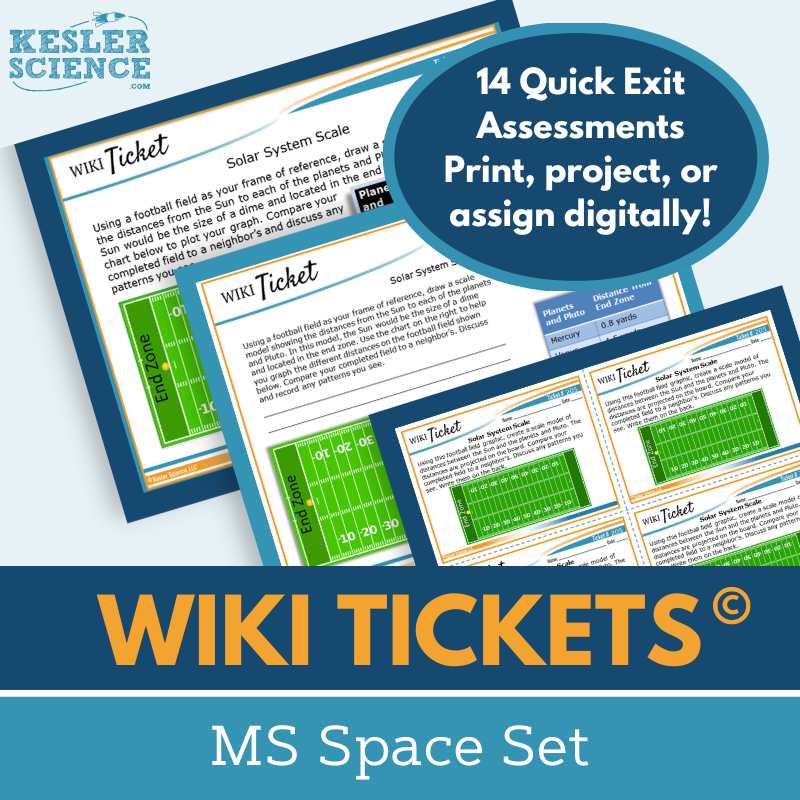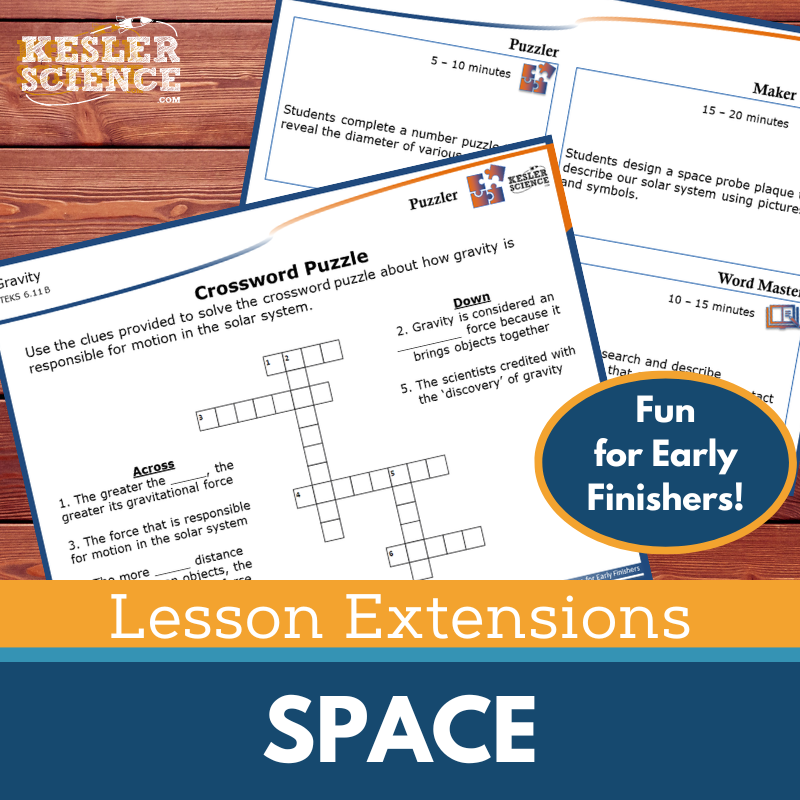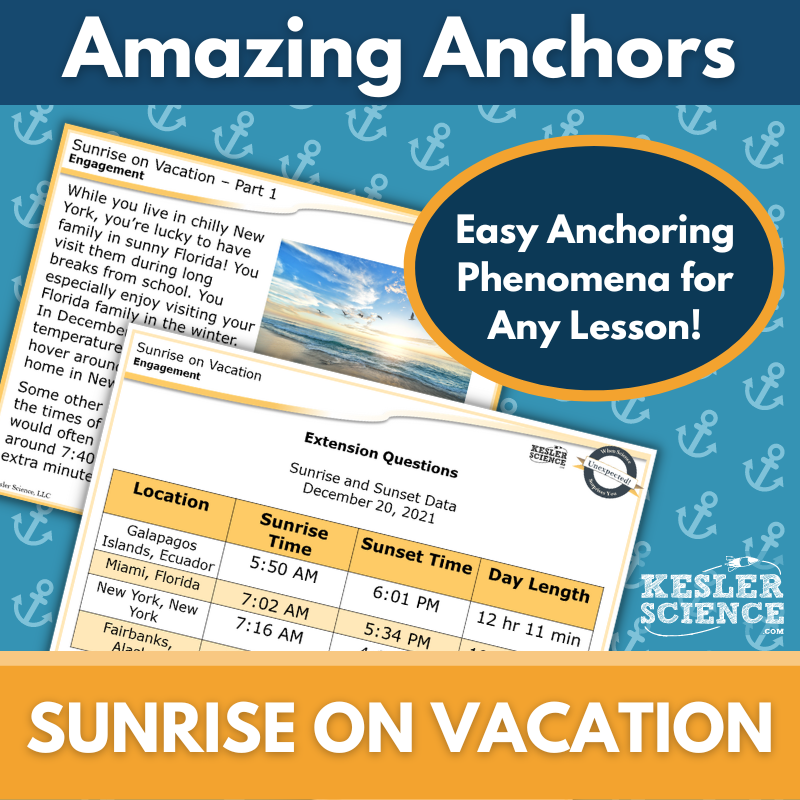Model Earth's Tilt & Seasons Activities for Middle School Science
This middle school space science unit, aligned with TEKS 6.9A, helps students understand how Earth's tilt affects sunlight and seasons. The resources below will give students a comprehensive understanding of Earth's tilt and seasons. All of the following materials are also included in the Kesler Science Membership.
The middle school space science unit focuses on modeling how Earth’s tilt affects sunlight and seasons. It includes editable PowerPoints, worksheets, student-choice projects, and assessments, with minimal prep required. The lesson is aligned with TEKS 6.9A and designed for differentiated, student-led learning.
Students will explore how Earth's tilt causes seasonal changes through a hands-on, multimodal station lab. With nine stations, students engage in activities such as reading comprehension, watching videos, conducting experiments, and organizing information. They will also demonstrate their understanding by categorizing, writing, illustrating, and answering formal assessment questions. A bonus "Challenge It!" station provides extension activities for early finishers.
The lesson offers flexibility with printable and digital formats, including Spanish translations of key materials. Interactive notebooks and PowerPoint presentations support students’ learning in both classroom and virtual settings. Assessment questions are aligned with STAAR 2.0, and review questions are provided for practice.
This unit is ideal for keeping middle school students engaged while allowing teachers to focus on student success.
The middle school space science unit focuses on modeling how Earth’s tilt affects sunlight and seasons. It includes editable PowerPoints, worksheets, student-choice projects, and assessments, with minimal prep required. The lesson is aligned with TEKS 6.9A and designed for differentiated, student-led learning.
Students will explore how Earth's tilt causes seasonal changes through a hands-on, multimodal station lab. With nine stations, students engage in activities such as reading comprehension, watching videos, conducting experiments, and organizing information. They will also demonstrate their understanding by categorizing, writing, illustrating, and answering formal assessment questions. A bonus "Challenge It!" station provides extension activities for early finishers.
The lesson offers flexibility with printable and digital formats, including Spanish translations of key materials. Interactive notebooks and PowerPoint presentations support students’ learning in both classroom and virtual settings. Assessment questions are aligned with STAAR 2.0, and review questions are provided for practice.
This unit is ideal for keeping middle school students engaged while allowing teachers to focus on student success.
This modular, student-led station lab for TEKS 6.9A engages middle school students in modeling Earth’s tilt and seasons. Designed for in-class or virtual learning, students will independently explore how Earth’s tilt causes seasonal changes through nine differentiated stations.
The stations include activities such as watching videos, reading passages, conducting research, and hands-on tasks. Students will use manipulatives or digital tools like PowerPoint or Google Slides to model Earth’s tilt, and then demonstrate their understanding through illustrations, written responses, and assessments. A bonus challenge station offers extension activities for advanced learners.
The lab encourages student-directed learning with minimal prep for teachers, making it an ideal resource for both in-person and online classrooms.
This modular, student-led station lab for TEKS 6.9A engages middle school students in modeling Earth’s tilt and seasons. Designed for in-class or virtual learning, students will independently explore how Earth’s tilt causes seasonal changes through nine differentiated stations.
The stations include activities such as watching videos, reading passages, conducting research, and hands-on tasks. Students will use manipulatives or digital tools like PowerPoint or Google Slides to model Earth’s tilt, and then demonstrate their understanding through illustrations, written responses, and assessments. A bonus challenge station offers extension activities for advanced learners.
The lab encourages student-directed learning with minimal prep for teachers, making it an ideal resource for both in-person and online classrooms.
The Model Earth’s Tilt & Seasons Student Choice Projects align with the 2021 TEKS standard 6.9A, offering middle school students the opportunity to select a project that suits their preferred output style. The project page outlines six student-led options, plus a “design your own” project. An editable grading rubric allows for assessments by teachers, peers, or students. This resource is also included in the Model Earth’s Tilt & Seasons Complete Lesson for TEKS 6.9A.
These flexible projects support differentiation, with a modified version offering options for students needing remediation and a challenge version for advanced learners. Teachers can easily adjust the rubric to meet grading needs. The multimodal options allow students to showcase their understanding in creative ways.
The projects require standard classroom supplies such as paper, markers, and scissors, and many options are available for digital completion.
The Model Earth’s Tilt & Seasons Student Choice Projects align with the 2021 TEKS standard 6.9A, offering middle school students the opportunity to select a project that suits their preferred output style. The project page outlines six student-led options, plus a “design your own” project. An editable grading rubric allows for assessments by teachers, peers, or students. This resource is also included in the Model Earth’s Tilt & Seasons Complete Lesson for TEKS 6.9A.
These flexible projects support differentiation, with a modified version offering options for students needing remediation and a challenge version for advanced learners. Teachers can easily adjust the rubric to meet grading needs. The multimodal options allow students to showcase their understanding in creative ways.
The projects require standard classroom supplies such as paper, markers, and scissors, and many options are available for digital completion.
This Inquiry Lab aligns with TEKS standards by helping students understand how Earth’s rotation causes day and night, and how Earth’s revolution around the Sun leads to seasonal changes. The resource includes three differentiated labs to meet the needs of all learners.
The labs are designed at three levels: the Dependent Student Lab offers guided instructions and inquiry questions, ideal for on-level learners; the Modified Student Lab is more structured with sentence stems and multiple-choice questions for students requiring modifications; and the Independent Student Lab is most student-centered, encouraging advanced learners to take charge with minimal guidance.
Teacher resources include prep materials, standards/objectives, directions, and editable pages. Reflection questions and answer keys are also provided.
Materials needed for each group include a Styrofoam ball with Earth’s key lines marked, a light source, a cup or dowel to hold the Earth model, and internet access.
This Inquiry Lab aligns with TEKS standards by helping students understand how Earth’s rotation causes day and night, and how Earth’s revolution around the Sun leads to seasonal changes. The resource includes three differentiated labs to meet the needs of all learners.
The labs are designed at three levels: the Dependent Student Lab offers guided instructions and inquiry questions, ideal for on-level learners; the Modified Student Lab is more structured with sentence stems and multiple-choice questions for students requiring modifications; and the Independent Student Lab is most student-centered, encouraging advanced learners to take charge with minimal guidance.
Teacher resources include prep materials, standards/objectives, directions, and editable pages. Reflection questions and answer keys are also provided.
Materials needed for each group include a Styrofoam ball with Earth’s key lines marked, a light source, a cup or dowel to hold the Earth model, and internet access.
The Seasons Escape Room offers an interactive way for students to explore concepts like Earth's rotation, revolution, and the causes of day and night and seasons. Aligned with TEKS and NGSS, students model how Earth's tilt and movement result in these phenomena.
Teachers can customize the escape room by selecting from eight independent puzzles, giving flexibility for different class periods. The escape room can be run using simple materials like manila envelopes for each puzzle or more elaborate setups with locks and a storage box for a more immersive experience. Both methods require printed materials, spinning wheels, invisible ink pens, and brads to assemble the puzzles.
For online use, teachers can assign a digital version in PowerPoint or Google Slides, or send a print version for home use. The package includes teacher directions, answer keys, a digital answer sheet, editable templates, and a video challenge. It also features eight unique puzzles, over 50 prize ideas, reward templates, and props like signs for a picture at the end. This engaging and flexible escape room ensures that students will remember the experience long after it’s over.
The Seasons Escape Room offers an interactive way for students to explore concepts like Earth's rotation, revolution, and the causes of day and night and seasons. Aligned with TEKS and NGSS, students model how Earth's tilt and movement result in these phenomena.
Teachers can customize the escape room by selecting from eight independent puzzles, giving flexibility for different class periods. The escape room can be run using simple materials like manila envelopes for each puzzle or more elaborate setups with locks and a storage box for a more immersive experience. Both methods require printed materials, spinning wheels, invisible ink pens, and brads to assemble the puzzles.
For online use, teachers can assign a digital version in PowerPoint or Google Slides, or send a print version for home use. The package includes teacher directions, answer keys, a digital answer sheet, editable templates, and a video challenge. It also features eight unique puzzles, over 50 prize ideas, reward templates, and props like signs for a picture at the end. This engaging and flexible escape room ensures that students will remember the experience long after it’s over.
This lesson explores the causes of day, night, and seasons through a nonfiction article, followed by comprehension questions and research on solstices and equinoxes. Designed for middle school students, the passage supports both science literacy and reading comprehension.
The resource includes a leveled science article appropriate for grades 6-8, with Lexile levels ranging from 1100-1300, and a mini-project that encourages hands-on, interactive learning. Typically, there are 5-7 comprehension questions, and a Cornell notes template is available. Colorful graphics enhance the passage and are suitable for printing in grayscale.
This resource is versatile for both in-person and virtual learning environments, compatible with platforms like Google Classroom, MS Teams, Schoology, and Canvas. Students can directly respond in the document via Google Slides or PPT.
Ideal for absent students, extra credit, or science sub plans, this passage can be used in various ways: for building routine, reinforcing specific topics, or promoting classroom discussions. It also helps develop students' textual analysis and reading comprehension skills.
This lesson explores the causes of day, night, and seasons through a nonfiction article, followed by comprehension questions and research on solstices and equinoxes. Designed for middle school students, the passage supports both science literacy and reading comprehension.
The resource includes a leveled science article appropriate for grades 6-8, with Lexile levels ranging from 1100-1300, and a mini-project that encourages hands-on, interactive learning. Typically, there are 5-7 comprehension questions, and a Cornell notes template is available. Colorful graphics enhance the passage and are suitable for printing in grayscale.
This resource is versatile for both in-person and virtual learning environments, compatible with platforms like Google Classroom, MS Teams, Schoology, and Canvas. Students can directly respond in the document via Google Slides or PPT.
Ideal for absent students, extra credit, or science sub plans, this passage can be used in various ways: for building routine, reinforcing specific topics, or promoting classroom discussions. It also helps develop students' textual analysis and reading comprehension skills.
The Day, Night, and Seasons Science Writing Prompt Activity engages middle school students in creative songwriting exercises to deepen their understanding of Earth science. Aligned with TEKS, students model and illustrate how the tilted Earth causes day and night through rotation, and how its revolution around the Sun results in seasonal changes. This student-centered, low-prep activity supports both in-person and virtual learning environments.
The resource includes teacher directions with an answer guide, project ideas, and rubrics; a projection version for classroom sharing or virtual use; full-sized handouts with the writing prompt, self-check, pre-writing strategy, and layout template; half-sheet handouts for interactive notebooks; and a digital PowerPoint version for easy Google Slides integration. It’s ideal for cross-curricular use, pre-assessments, student projects, or enrichment for early finishers. This writing prompt also works well for extra credit, make-up work, TELPAS samples, and differentiation.
Perfect for display or as part of a student anthology, these prompts assume prior knowledge of the topic or access to research materials.
The Day, Night, and Seasons Science Writing Prompt Activity engages middle school students in creative songwriting exercises to deepen their understanding of Earth science. Aligned with TEKS, students model and illustrate how the tilted Earth causes day and night through rotation, and how its revolution around the Sun results in seasonal changes. This student-centered, low-prep activity supports both in-person and virtual learning environments.
The resource includes teacher directions with an answer guide, project ideas, and rubrics; a projection version for classroom sharing or virtual use; full-sized handouts with the writing prompt, self-check, pre-writing strategy, and layout template; half-sheet handouts for interactive notebooks; and a digital PowerPoint version for easy Google Slides integration. It’s ideal for cross-curricular use, pre-assessments, student projects, or enrichment for early finishers. This writing prompt also works well for extra credit, make-up work, TELPAS samples, and differentiation.
Perfect for display or as part of a student anthology, these prompts assume prior knowledge of the topic or access to research materials.
These formative assessments for 6th-8th grade science offer flexible options to check students' understanding in a fun, engaging way. The Space Set includes 14 topics, each with five format options: a full-screen projection version, three handout sizes (full, split, and quarter-page), and an interactive digital version for PowerPoint or Google Slides.
Aligned with NGSS and TEKS standards, some topics feature multiple tickets, and each standard has at least one ticket. A table of contents file is included to show alignment.
These assessments are designed for both in-person and virtual learning environments, making them versatile for various teaching settings. Topics covered include day, night, and seasons; electromagnetic spectrum; lunar cycle; space exploration; the Sun; and more.
WIKI Tickets© are great for exit tickets, bellringers, or quick checks. They can be projected for students to write on paper, printed in handout form, or assigned digitally for remote learning.
These formative assessments for 6th-8th grade science offer flexible options to check students' understanding in a fun, engaging way. The Space Set includes 14 topics, each with five format options: a full-screen projection version, three handout sizes (full, split, and quarter-page), and an interactive digital version for PowerPoint or Google Slides.
Aligned with NGSS and TEKS standards, some topics feature multiple tickets, and each standard has at least one ticket. A table of contents file is included to show alignment.
These assessments are designed for both in-person and virtual learning environments, making them versatile for various teaching settings. Topics covered include day, night, and seasons; electromagnetic spectrum; lunar cycle; space exploration; the Sun; and more.
WIKI Tickets© are great for exit tickets, bellringers, or quick checks. They can be projected for students to write on paper, printed in handout form, or assigned digitally for remote learning.
Lesson Extensions offer engaging, student-choice activities designed to challenge fast finishers and deepen understanding of space science standards. These activities keep students engaged with critical thinking and creativity, making them ideal for lesson wrap-ups, testing downtime, or curbing distractions.
Each Lesson Extension includes four components: Puzzler for problem-solving, Maker Space for hands-on STEAM activities, Tech Connection for digital demonstrations, and Word Master for creative writing. Teacher directions, answer keys, and both projection and print versions are provided for ease of use.
These extensions are perfect for scaffolding learning and enriching students who are ready to explore topics like space science. The topics covered include components of the universe, Earth, the Moon, and the Sun, gravity, humans in space, lunar cycle, solar system objects, space travel, and more. The extensions are aligned to NGSS and TEKS science standards.
Lesson Extensions offer engaging, student-choice activities designed to challenge fast finishers and deepen understanding of space science standards. These activities keep students engaged with critical thinking and creativity, making them ideal for lesson wrap-ups, testing downtime, or curbing distractions.
Each Lesson Extension includes four components: Puzzler for problem-solving, Maker Space for hands-on STEAM activities, Tech Connection for digital demonstrations, and Word Master for creative writing. Teacher directions, answer keys, and both projection and print versions are provided for ease of use.
These extensions are perfect for scaffolding learning and enriching students who are ready to explore topics like space science. The topics covered include components of the universe, Earth, the Moon, and the Sun, gravity, humans in space, lunar cycle, solar system objects, space travel, and more. The extensions are aligned to NGSS and TEKS science standards.
This Amazing Anchors lesson on the Earth's day, night, and seasons is a no-prep resource designed to enhance middle school science lessons. It includes two parts: an introductory reading on the Sun's rise and set times in different locations, followed by comprehension and extension questions to prepare students for further learning. The second part is an explanatory reading on the science behind days, nights, and seasons, with additional questions to reinforce understanding.
The lesson includes teacher directions with answer keys, a projection version for displaying slides, and both print and digital formats for easy use in classrooms and LMS platforms like Google Classroom. A modified version with sentence starters is also available to support students.
Aligned with TEKS, this resource serves as a supplement to your lesson, offering an engaging way to explore these concepts through a real-world lens.
This Amazing Anchors lesson on the Earth's day, night, and seasons is a no-prep resource designed to enhance middle school science lessons. It includes two parts: an introductory reading on the Sun's rise and set times in different locations, followed by comprehension and extension questions to prepare students for further learning. The second part is an explanatory reading on the science behind days, nights, and seasons, with additional questions to reinforce understanding.
The lesson includes teacher directions with answer keys, a projection version for displaying slides, and both print and digital formats for easy use in classrooms and LMS platforms like Google Classroom. A modified version with sentence starters is also available to support students.
Aligned with TEKS, this resource serves as a supplement to your lesson, offering an engaging way to explore these concepts through a real-world lens.
Year-Round Resources
These year-round activities will increase your students' understanding of many middle school science topics. All of these activities are also included in the Kesler Science Membership.
Visual Data & Graphing
You're not alone if your students struggle with understanding graphs, charts, and tables. It's a skill that takes an enormous amount of practice. This resource will help students build a strong foundation in analyzing data and creating their own data visualizations.
Bell Ringers and Warm-Ups
These middle school science bell ringers are an excellent way to engage your students as soon as they walk into your classroom. This comprehensive FULL YEAR resource includes everything you need to start off each science class with an interesting warm-up activity.
Review Board Games
Each game board has been carefully designed to keep students engaged. There are 10 different action spaces on each board and dozens of question cards. All of the actions are related to science concepts and keep the students motivated throughout the game.
Each game is ready to play. Simply print out the board and the cards and let the students enjoy reviewing nine different units.
Essential Questions and Standards
Below are the essential questions and standards associated with the lessons and activities included in the atoms unit. This topic is only one of more than 100 middle school science topics included in the Kesler Science Membership.
-
How can we model and illustrate how the tilt of the Earth causes changes in seasons?
-
TEKS Science - 6.9A Model Earth's Tilt & Seasons
Kesler Science Membership
Imagine never having to search for another middle school science lesson again. The membership gives you access to ALL of the Kesler Science products in one place (Yes, including everything above).
Say goodbye to long hours of lesson prep.



